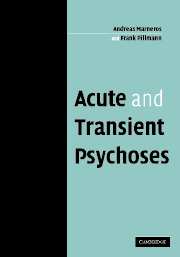Book contents
- Frontmatter
- Contents
- Preface
- Acknowledgements
- Part I History and concepts
- Part II Studies and findings
- Part III Issues of nosology
- 11 Defining the brief, acute and transient psychotic disorders: the polymorphic psychotic core
- 12 What are brief, acute and transient psychotic disorders?
- 13 Brief polymorphic psychoses as a component of a psychotic continuum
- References
- Index
11 - Defining the brief, acute and transient psychotic disorders: the polymorphic psychotic core
from Part III - Issues of nosology
Published online by Cambridge University Press: 07 August 2009
- Frontmatter
- Contents
- Preface
- Acknowledgements
- Part I History and concepts
- Part II Studies and findings
- Part III Issues of nosology
- 11 Defining the brief, acute and transient psychotic disorders: the polymorphic psychotic core
- 12 What are brief, acute and transient psychotic disorders?
- 13 Brief polymorphic psychoses as a component of a psychotic continuum
- References
- Index
Summary
The boundaries of homogeneity
Both APA and WHO try to define ‘Brief Psychoses’ and ‘Acute and Transient Psychotic Disorder’, respectively, by using the time factor (duration of an episode of the disturbance is at least 1 day, but less than 1 month) as well as the cultural aspect (a symptom is not included if it is a culturally sanctioned response pattern, see p.) and by the exclusion of the effects of a substance or of general medical conditions. The WHO tries to achieve homogeneity on the one hand by using similar exclusion criteria like those of DSM-IV (time factor, organic cause, etc.), but on the other by defining subgroups (see p. 7ff). The first way, the time factor, however, applied by the WHO is somewhat more complicated than that of the APA. The first time factor used by the WHO concerns the development of symptoms (the time-interval between the first appearance of any psychotic symptoms and the presentation of the fully developed disorder should not exceed 2 weeks). And the second factor, the duration of an episode, depends on the type of the subgroup: the total duration of the disorder in the subgroups with schizophrenic symptoms (F23.1: Acute Polymorphic Psychotic Disorders with Symptoms of Schizophrenia, F23.2: Acute Schizophrenia-like Psychotic Disorders) must not exceed 1 month. This is also valid for the unspecified type (F23.8).
- Type
- Chapter
- Information
- Acute and Transient Psychoses , pp. 173 - 196Publisher: Cambridge University PressPrint publication year: 2004



